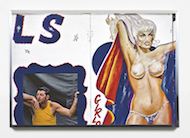Susan Meiselas was twenty-four years old when she began photographing the women of carnival strip shows, in 1972. The following three summers, at small-town fairgrounds on the East Coast, she captured the performers both onstage and off, nude and not, in dim, makeshift dressing rooms or outdoors in sunshine, against a shifting backdrop of box trucks, tents, and painted plywood sets. Meiselas’s images show the carnival as a dynamic world of spontaneous action and hot lights, of whooping or transfixed crowds, and of gruelling and often tedious work. The project was originally published in book form, in 1976. In the decades since, the subculture has gone extinct as the sex industry has radically transformed, but “Carnival Strippers”—which Steidl and C/O Berlin have newly reissued, with a fascinating companion volume, titled “Making Of”—remains a remarkable document of the time.
On a recent day, at her studio on Mott Street, in New York, Meiselas showed me a pair of closeup photos—one black-and-white, one color—of a pelvis covered by a triangle of bikini bottom, a tassel hanging from the crotch. They’re of a performer named Shortie, one of Meiselas’s most frequent carnival models. “I don’t know how that all happened—who I was, how she saw me, how I understood myself,” Meiselas said, reflecting on the intimate character of the pictures and on the uncommonly close relationships she developed with Shortie and the other “girl show” workers. The women often chose how they posed and dressed for the camera, but Meiselas was also witness to spontaneous and unguarded moments. Her camera’s perspective conveys her presence in the thick of things, in spaces far too small for her to play a fly on the wall. In some of her most striking images, she’s waiting with nude women, perhaps in the pauses between shows, or she shoots from the wings as they rush onstage.
Back then, Meiselas told me, “I wasn’t even defining myself as a photographer.” But it wasn’t long before she became associated with the storied agency Magnum Photos, and by the end of the seventies she was travelling to Central America, just before the start of the Nicaraguan Revolution. Her most famous picture from the time, “Molotov Man,” a shot of a Sandinista fighter with a flaming Pepsi bottle in his hand, became an iconic image of the Somoza regime’s fall and a global symbol for antiauthoritarian insurgency. In retrospect, “Carnival Strippers” can be seen as a formative chapter in Meiselas’s prolific and varied career. Already, the photographer’s uncanny dexterity, nuance, and sense of timing are clear. The project also shows Meiselas beginning to grapple with the ethics of representation, feeling out the fine line between outsider and interloper and the power imbalances between a photographer and her subjects. In an interview included in the book, a performer named Lena tells Meiselas, “They think of carnival people as low anyway, and a carnival stripper they think is lower.” She’s referring to the male audience members who treat her poorly, but she could easily be speaking of society more broadly—and of the audience for Meiselas’s pictures, too.
The book pairs black-and-white photos of the women with first-person accounts of their lives in the carnival, and sometimes what brought them there. Back then, “we didn’t use the word ‘agency,’ ” Meiselas said. But the fundamental aims of the women’s movement at the time—sexual freedom, self-determination, and financial independence—emerge, in her book, as motivating forces for the strippers, even if the movement might have deemed women like them choiceless. Lena, whom Meiselas became close to, speaks of feeling more “respected” by other women when she worked as a waitress, but adds, “I prefer dancing. . . . When you dance you can be anything you want.”
The new companion volume includes archival material—correspondence, ephemera, contact sheets, handwritten notes—and previously unpublished color photos, which are the subject of an exhibition currently on view at Higher Pictures Generation, in Dumbo. They bring lush new dimension to the ragged glitz of the carnival, as seen in “Last Call at Mini Club,” from 1973, which features a stage from a distance, blazing red and gold, as night descends. Such moody, open-air images are a foil to the close shots and interiors, such as the black enclosed space of “Shortie on Stage,” from 1973. In that striking scene—which might read as a visual treatise on the “male gaze” avant la lettre—men in the front row lean on the platform’s edge to regard the stripper’s reclining figure. Shortie’s back is to the viewer, while Meiselas seems to be crouching somewhere at the back of the stage. The audience members grin as they watch the show—except for one attendee, curious or hostile, whose eyes are trained on the young woman behind the lens.

